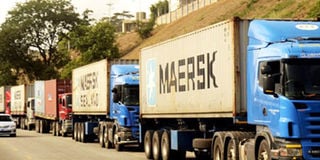High transport costs hinder Free Trade Area in Comesa

Cargo. Trucks transporting cargo from Mombasa Port to Kampala wait to be cleared recently. High transport costs are hindering the progress of regional Free Trade Area. FILE PHOTO
What you need to know:
Decline. The drop in both exports and imports was largely due to declines in commodity prices, including fuel, ores and metals.
Records. Comesa’s global total exports recorded a decline of 7 per cent in 2016 at $71b (Shs257 trillion) from $76b (Shs275 trillion) in 2015. The global imports also declined by 8 per cent from $179 billion in 2015 to $165 billion in 2016. The decline was largely due to declines in commodity prices including fuel, ores and metals.
Kampala. Prohibitive costs of transportation in the Common Market for Eastern and Southern Africa (Comesa) region are the main handicap towards the successful implementation of the regional Free Trade Area (FTA).
FTA is a group of countries within which tariffs and non-tariff trade barriers between the members are generally abolished but with no common trade policy toward non-members.
And because of the high transport costs, during their annual meeting in Lusaka, Zambia recently, the Comesa Council of Ministers approved a proposal to establish a shipping line that would serve both inland and coastal countries.
According to the head of corporate and communication affairs, Mr Mwangi Gakunga, this will be done through regional institutions and member states.
“In approving this intervention, the ministers noted that addressing the high transportation costs would resolve the challenges affecting the performance of the FTA,” Mr Gakunga said.
FTA performance
An assessment conducted earlier by the Comesa secretariat on the performance of the FTA, indicated that the average bilateral intra-Comesa trade cost stands at 310 per cent of the value of trade.
This is much higher than the bilateral intra-regional costs of trade for East Asia and Pacific; Europe and Central Asia; Latin America and the Caribbean; Middle East and North Africa; South Asia and sub-Saharan Africa.
The main challenges include high trade cost that could be attributed to both direct and indirect costs associated with fulfilling regulatory import and export requirements, costs resulting from differences in currencies, geographical distance, domestic and international shipping and logistics costs associated with imports and exports.
Other proposed intervention identified during the assessment was the need to establish public private partnerships, especially in the development of transport and logistics infrastructure. “For Comesa member states to realise the highest levels of innovation-based growth in exports and produce high-value added products for long-term growth, there is need to redesign policies geared towards facilitating adoption of existing technology, intellectual property rights and vocational education that would bolster innovation capacity,” said, in part, the assessment report.
The assessment indicated that the low levels of trade complementarity among member states could be addressed through establishment of regional production networks.
Thus member states needed to eliminate and avoid imposition of non-tariff barriers and relax rules of origin to enhance intra-Comesa trade.
In its decision, the Council directed the Secretariat to expeditiously undertake detailed analysis on the rules of origin, trade costs, transportation costs and other elements affecting intra-Comesa trade.




